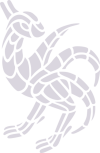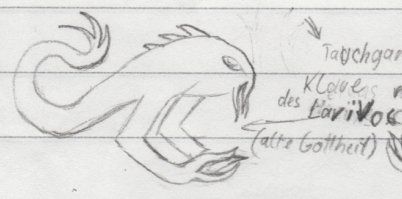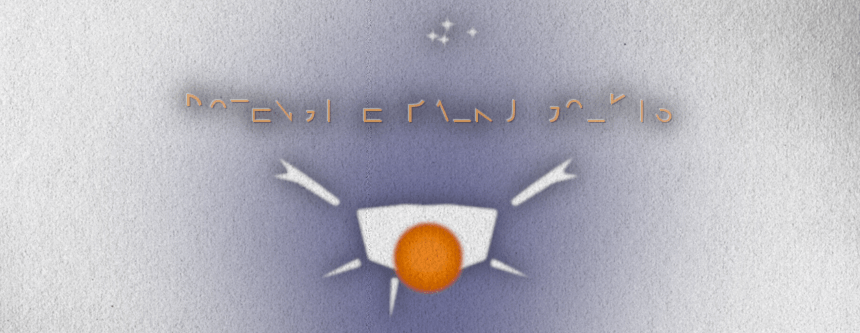
How do I create an alien language?
Project "Nonfi Nis" - Week 46
Last time I said that I'd try to write another blog post before WorldEmber. And for once, I actually do as planned! This weekend I spent a considerable amount of time translating a piece of text to the language of the Rilanga, so I'd love to talk about artificially constructed languages, also known as "conlangs".
Why bother with an alien language in the first place?
I've been fascinated by foreign languages since school. I enjoyed learning English, Latin, French and Spanish there, and during my university years I took an introductory course in Japanese. When my day job took me to conferences abroad, I used that as an excuse for looking into Dutch and Turkish.
Sadly, so far English is the only language I've learned well enough to feel comfortable writing and speaking it. Now and then I make half-hearted attempts at refreshing my memory and improving in the other ones, but adult life leaves me with too little time for that.
But the fascination never left - it even grew when I encountered fictional languages. Of course, like every good nerd, I was tempted to learn Klingon every now and then. I took notes of Goa'Uld words while watching Stargate. And when I was gifted the second book of the Inheritance Cycle, I loved the detailed appendix explaining that world's languages. (Never got around to reading the rest of that series, unfortunately.)
Languages are a massively important part of daily life, so adding one to a fictional world helps a lot with making that world feel alive. Imagine a character cursing in their native tongue, or an elegantly flowing phrase which drives home how sophisticated a particular culture is. It can also add interesting complications by introducing a language barrier and the need for one character to translate for the others.
For "Nonfi Nis", I plan to do a bit of both - creating an immersive, alien atmosphere, and confronting the protagonist family with speakers of a different language.
To give you a taste of what I'm talking about, here's me reading a text in Rile, the language of the Rilsu.
Te-Sakal, upon being awarded the Spring Crab Medal
"I feel deeply honored to receive this award.
I thank you for the trust that you placed in Ub Lenliz Lu Kegmilut,
and I am proud to say that we delivered on our promises.
But still, the greatest reward is to see the plants grow, blossom and bear fruit after all these years.
We have shown that this world is far from dead. We have shown that there is a future waiting for us.
And I promise you - I promise you all - that the feast we just shared will merely be the first of many to come."
Where does this language come from?
Well, when a mommy language and a daddy language love each other very much...
No, seriously, that's not too far from the truth. Understanding real languages is an important foundation for creating one of your own. The more, the better. Besides teaching you about important common principles, this also gives you a lot of inspiration to draw from.
Basic Look And Feel
When I sat down to redesign my alien cultures in 2016, I picked one or two real-world cultures as a starting point for developing each one's look and feel. Calyrra's people got ancient Greece and Rome, and their mortal enemies got Spanish conquistadores and Aztecs. The Rilsu got modern-day Japan. And Those Who Know... uh, okay, they're the odd ones out. They're mostly based on Goth aesthetics, and they don't have a spoken or written language anyway.
So let's focus on the Rilsu, the culture which emerged from those in the "Nonfi Nis" setting. A key element that I took away from my beginner's course in Japanese was a lack of exotic vowels - no Y, no umlaut characters, no nasals. As for the consonants, there were no "compound" sounds like the German X (spoken as "ks") or Z (spoken as "ts"). Therefore, my first step was to eliminate unnecessary letters from the Rilsu alphabet.
Finding Patterns
Once I had the sounds figured out, I took a closer look at the names from my early drafts. Teenage me had mostly taken random sounds and mashed them together until the result sounded interesting. Back then I wasn't thinking about cultures, either, so the look and feel was all over the place. Time to change that.
There were two names in particular that caught my attention - Larxeon, the name of the system's star, and LariVoc, the name of some eldritch Temrophian deity. And somehow it occurred to me that the "lar" syllable could be a common root and a word of its own.
I decided to simplify these two names according to the reduced Rilsu alphabet. Larxeon became Larekon and LariVoc became Larivok. This made me notice the next interesting tidbit - a bright vowel joining the word "lar" to another one. Hmm, why not make them the same vowel? I settled on the E.
 |
So what else could these names have in common? What could the word "lar" mean? Well, at this point I already knew that Those Who Know did not worship any eldritch deities, and probably never had. (I still love the design of that beast, though. Looks like I'll have to find a different way to work it into this world.) |
But what did matter to them - immensely - was the Kaleidoscope. And there was the connection that I had been looking for. Both the star and the Kaleidoscope were important celestial bodies, two bright things in the sky for which the Rilsu would need names.
Whoa... the puzzle pieces began to fall into place! "Lar" came to mean "sky". "Kon" became "eye" and "vok" became "fire", matching the appearance of the respective objects. The "e" came to mean "in", joining the two nouns in an unfamiliar order. Now I already had three - no, four - words of an alien language and a first bit of grammar to go with it. Neat.
The Magic Of Technological Progress
Still, at that point I never thought I would develop a full language from that, let alone translate entire sentences. Since I wasn't even able to learn all the real-world languages that I wanted, I figured that this approach would only give me a couple of alien words to throw in for flavor now and then. And for several years, I was fine with that.
Then, at the beginning of 2020, I stumbled across WorldAnvil. And while exploring the template for language articles, I discovered something else - an import function for languages generated with a tool called
Vülgår. Huh. That sounded interesting, so I decided to check it out. And gosh, am I glad that I did.
Computer-Aided Language Generation
I already loved the idea of using computer-generated content in my Kaleidoscope game because you're unlikely to be surprised by something that you created yourself. And I want to be surprised. I want to explore.
Therefore it felt quite logical to let a web tool generate a language based on my preferences. As it turned out, that tool had pretty much everything I needed. It let me select the precise sounds that I wanted in my alien language. It let me limit what kind of sounds could occur together and handled the translation from IPA to Unicode characters. I could define suffixes for verbs, noun gender and the like.
But what I enjoyed most was the ability to explore my culture's language - to discover the words that Vülgår had generated for me, to get inspired by the grammar it suggested, to find out what I liked and what needed tweaking. And within a few days of playing with that tool I had usable conlangs for the Rilsu, the Nimýric Empire and the Pereqaian Alliance. Much more than I ever dreamt I would have.
Polishing The Raw Material
A computer-generated dictionary is a good starting point, but a piece of software can't read my mind. So obviously I keep finding imperfections that need manual refinement. There are some words that don't quite fit the desired look and feel, ones that are too complicated for my taste, or ambiguities and unfortunate similarities.
Like most of my worldbuilding, the languages are a permanent work in progress - anything might change if I happen to find a reason for it. Which is not so different from the way languages work in real life. They evolve as people simplify frequently-used terms or name their new inventions and discoveries.
When I come across a word that I do not like, I change it or delete it. When I don't find the word I need, I look for synonyms or transform adjectives into nouns and vice versa. And of course, sometimes I add new words to the dictionary.
Getting To Know My Language
The best way to familiarize oneself with an unknown language is to actually use it. This is why I made a habit of translating my worldbuilding concepts to the respective conlang.
This helps me with finding words that don't fit in, figuring out what is missing, and deciding and refining the grammar rules. Besides that, it's a wonderful way to add a unique flavor to my world.
Names That Actually Make Sense
Gone are the days of mashing together random sounds. Today I have mostly moved on to using "proper" words for locations, people or species. I usually start with the words that I find in the dictionary and experiment with ways to combine and streamline them. Sometimes I also work backwards and create proper words from the random sounds that I chose in the past.
Take, for example, the following locations from Ranul.
| Location Name | Source Words | Modification | Notes |
|---|---|---|---|
| Mustik Hamesi | mustik=side hamesi=inside |
none | |
| Ralenlos Mountains | ral=mountain lenlos=enormous |
joined at the shared consonant | "ral" is reverse-engineered from the name "Ranul" which probably means something related to "rock", and the redundant English word "mountains" is added to make it easier for the casual reader |
| Leokolriz | lehos=stream gol=two rezu=nation |
swapped some sounds for similar ones, dropped others | simulated variation over time - this nation existed before the Final War, so it used a slightly different language |
| Zakidema | zak=town degma=green |
removed the G, added I between the words | streamlined to avoid two consonants in a row, which is also more in line with Japanese syllables |
Translating Sentences
The next step for me was translating actual phrases and digging into the grammar. As in, figuring out the order of the different types of words, choosing the proper tenses and all that.
I started with short quotes that I could insert into articles. Simple phrases with just a couple of words and a straightforward structure. For Rile, one of the first was the Rilsu motto. Let me walk you through this example.
First, we need the English phrase: "In destruction lies a lesson."
Now think back to Larekon and Larevok. When one thing is inside another thing, the latter comes first, followed by the preposition "e" and the thing in focus. So where does the verb go? Well, I don't remember whether it was suggested by the Vülgår tool or whether I chose that one freely. But I ended up with an object-verb-subject structure. This gives us the following: "Destruction in lies a lesson."
Somewhere along the way I had decided that I would keep things simple and not add rules for conjugating verbs in Rile. (Or any of my other conlangs, at least for now.) Also, the Rilsu avoid indefinite articles when they are not strictly necessary - some real-world language gave me that idea, but I'm not sure which one that was exactly. So anyway, let's apply that to the quote, and we get: "Destruction in lie lesson."
With the sentence structure figured out, I can turn to my computer-generated dictionary. The word for "destruction" in there is "dotengi". "Lesson" is "golkiz". So far, so good.
But the verb is trickier. There is only one entry for "lie", which is "masru". But there is no clue whether this is the word for being located somewhere or the one for telling lies. Now I have different options. I could either use "masru" because, well, there is nothing to indicate that it would be the wrong choice. Alternatively, I could look for a synonym. This gives me the verb "palru" with the meaning "be" as in "exist/there is". That one is perfectly clear, so let's use that one.
Time to assemble these words. Et voilà, the result is this: "Dotengi e palru golkiz."

Making Things Up As I Go
Translating longer texts is obviously more difficult. As the sentences get more complex, I'm more likely to reach the end of what the web tool generated. But remember what I said earlier - the best foundation for developing an alien language is knowing several real-world languages. When in doubt, I can refer to the grammar rules of those. I can borrow rules that I like, turn them upside-down to make my language more alien, or anything in-between.
One thing that I learned along the way is this: Whatever grammar rule I decide to add, I need to write it down for future reference. I do this in my WorldAnvil article for the respective language, like this one: Rile (language)
Examples never hurt, either. This is another good use for short quotes like the example from the previous section.
If you look at the Rile article, you'll find the phrase "Dotengi e palru golkiz" illustrating the sentence structure, and the name "Larekon" illustrating the placement of the "e".
By keeping my examples in one place, I can return to them easily and make sure that my translations are consistent. And the more I use my alien language, the more comprehensive and helpful will this reference become.
Wrapping It Up
There's much more to to say about this topic, but I guess I'll save that for later. Time to sum it up.
Languages are a fascinating element of any world, be it our own or a fictional one. Designing an alien language takes lots of steps, most of which get easier to handle with every real-world language that you can draw from.
- Start with setting the look and feel by picking one or more existing languages as your main inspiration.
- Brainstorm and re-visit old ideas to find out how they fit into said look and feel. You may even get a grammar rule or two out of that.
- Look for software tools to help with generating a large vocabulary, storing it and keeping it organized.
- Get to know and understand your language by using it. Test its limits by translating actual text snippets.
- Add to, modify and refine both your vocabulary and grammar whenever you reach those limits.
- Keep track of every rule you add, and use examples whenever you can.
Now, I can imagine writing further posts about this. For example, I could tell you how I designed the Rilsu alphabet and made the font. I could explain my approach for creating the predecessor languages Rilangun and Zuni. Oh, and I've dabbled with setting up a Text-To-Speech voice for the Nimýric language - doing the same for Rile should be fun, too! If any of these suggestions sound interesting to you, just let me know.
But now, WorldEmber is already knocking on the door. This time I'm determined to finally get those characters fleshed out... after all, I've been dancing around that task long enough. Well then, see you around!


